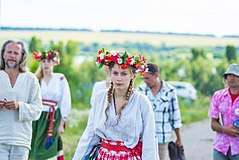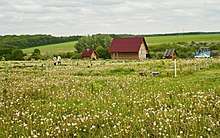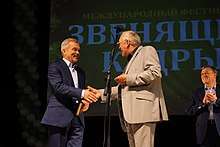Ringing Cedars' Anastasianism
The Ringing Cedars (Russian: Звенящие Кедры; also "Jingling Cedars"[1]) or Anastasianism (Анастасианство, Анастасиизм) is a new religious movement,[2] often classified as New Age,[3] that started in central Russia in 1997 and has since spread across the world.[4] Ringing Cedars' Anastasians are sometimes categorised as "Rodnovers", as many of them are proponents of the return to a Slavic Native Faith (Rodnovery) or other indigenous religion.[5] Other scholars do not categorise them as Rodnovers, but as a distinct modern Pagan movement.[6] Anastasianism has also been considered part of the broad spectrum of self-described "Vedic" religions arising in post-Soviet Russia.[5]

| Part of a series on |
| Slavic Native Faith |
|---|
 |
|
Denominations Not strictly related ones:
|
|
Spread |
|
Sources
|
The movement is based on the series of ten books entitled The Ringing Cedars of Russia written by Vladimir Megre.[4] The knowledge contained in the books is attributed to a beautiful woman named Anastasia, the embodied form of a deity,[7] who dwells in the Siberian taiga, whom Megre met during one of his trade expeditions.[8] At the 2018 Frankfurt Book Fair, where the author drew a large crowd,[9] it was claimed the books have sold 20 million copies worldwide and have been translated in 20 languages.[10]
The books offer a holistic worldview, teaching about humanity's relationship with nature, God and the universe, the creation of the world, the power of thought in modelling reality and the future, a cyclical eschatology, the relationship between men and women, and education.[4] The Anastasians propose a whole new model of social organisation, that of the "kinship homestead" (родовое поместье, rodovoye pomest'ye).[5] Family, tradition and environmentalism are core values for the Anastasians.[11]
The name "Ringing Cedars" comes from Anastasians' beliefs about spiritual qualities of the Siberian "cedar" (actually a species of pine).[5] The Ringing Cedars have become popular in Russia, and the movement has also spread to other Slavic countries, broader Eastern Europe, and communities have also been established in the West.[12] In Russia, Anastasians have faced the hostility of the Russian Orthodox Church.[13]
Etymology
The two names of the movement are explainable as follows: "Ringing Cedars" refers to the movement's beliefs about the spiritual qualities of the Siberian cedar, a kind of pine;[14] "Anastasia" (Ἀναστασία, Anastasía), from anástasis (ἀνάστασις), is a Greek phenomenological word meaning "resurrection".[15]
The theme of the "singing tree" appears across various Indo-European-originated cultures; Anastasians consider themselves the reintegrators or resurrectors of the authentic Vedic spiritual culture, authentic Russian religion consisting in the cultivation of Rod (God as generation/nature), which has been preserved over the centuries by Russian settlers and volkhvs (shamans) in Siberia who fled the Christianisation of Kievan Rus'—a Christianisation which was decided by the ruling elites in order to disrupt the ties of society and of human society with the natural world (ancestors and gods of the environment as the direct link to Rod) justifying the confiscation of all land and the enslavement of the population.[16]
Beliefs
.svg.png)
Theology
The Ringing Cedars may be described as a nature religion, since Anastasian spirituality emphasises the sacredness of nature or generation, conceived as a source of divinity and the means of communication with God (Rod). The scholar Rasa Pranskevičiūtė characterises this vision as pantheistic, and notes how it is a fundamental influence in Anastasians' social project.[17] They stress the importance of harmony, that is to say giving and receiving love and respect, appropriate reciprocal cultivation, to be put into practice among individual persons and between the community of individuals and the divinity of all nature.[18]
A Lithuanian Anastasian has defined God as follows:[19]
God is Nature – a twitter of birds, the wind, a rustle of trees... everything that is in Nature is the living book of sensual information, and much more: He touches us through Nature.
Anastasians believe that nature is the "materialised thoughts of God". All living things, and superior living beings or gods, are believed to be thoughts of God, and therefore by communicating with them humanity may communicate with God.[19] In Anastasian doctrines, the gods are "more or less concentrated energy clots in space", and influence the world on the energetic plane, while the supreme God is the "unified conscience of all living creatures". God and the many gods within it are impersonal and not to be worshipped.[1]
Some Anastasians consider Anastasia a deity, or the incarnation of a deity, patroness of ancestral estates and dacha owners (dachniki). According to other accounts, she received the knowledge contained in the books written by Vladimir Megre directly from the supreme God, through the ancestors.[7]
Morality
The Ringing Cedars believe in the interconnectedness of all being, and therefore they greatly emphasise the moral responsibility of individuals and humanity towards the surrounding world. They believe that human thoughts and feelings actively, magically influence the surrounding world, having the power to affirm or disrupt natural harmony. Pranskevičiūtė reports the following excerpt from Megre's doctrine (1998):[20]
When a man is full of love, he is entirely radiant. That energy of radiance reflects into the planets above him in a short particle of a second, comes back to earth again and gives life to everything that is alive... If a man is ful of anger, his disseminating radiance is dark; it cannot rise up and penetrated deeply into the Earth. After striking deep into the bowels [of the Earth], it comes back and manifests itself as a volcanic eruption, an earthquake, war.
In order to be respectful towards other forms of life, Anastasians try to eschew any form of killing, and therefore they adopt vegetarian, vegan, and raw food diets, and wear clothes made of natural materials.[20] The Anastasians also propose "traditional" values antagonistic towards the "wrong" values of modern Western lifestyle; they "do not want to compromise on specific questions like gender equality and capitalist economy".[21]
Heaven on earth and reincarnation

According to Megre, when a man lives in harmony with his own kin within a homestead of at least a hectare in size, a "love space" is established. A "love space" is where God is present, immanent, and constitutes a "Heaven on earth", where kindred people grow together with the surrounding world. The concept of "love space" is not merely geographic, but includes anything good which an individual may create.[22] A kinship homestead is also a web of natural relationship, between kindred people.[23]
In other words, the kinship homestead mirrors the modality of God's work through nature. In his hectare of land a man is capable of building a house with natural materials, growing plants and domesticating animals, creating an ecosystem.[24] As such it is perceived as a holy land, a microcosm reflecting the macrocosm, wherein individuals may "co-create" with kindred people and with God.[25] According to Anastasians' own experiences reported by Andreeva and Pranskevičiūtė, the new social organisation represented by the kinship homesteads helps people to leave the unnatural and decaying urban technocratic system, which they conceive as a close system which smothers human creativity ensnaring it in meaningless behaviours.[26]
A Russian Anastasian has described her experience of the kinship homestead as follows:[27]
[It is] a way to open your inner potential – it is the place where every person can open his inner potential to the maximum – in other words, to live in accordance with the programs which have been put by God... Through Nature you can gain insight into God's purpose.
The "love space" always corresponds to a transcendental space where an individual may be reborn. Anastasians believe that reincarnation may be consciously planned, and it occurs in the lineage. Reincarnation occurs within the "love space", or the established kin, because the offspring remember their ancestors. The Ringing Cedars believe that humans and all of reality is fundamentally energy of thought, and ancestors may be reborn if they are thought by their descendants.[22]
Eschatology
Anastasian doctrines about the crisis and degeneration of modern civilisation are inspired by thinkers of the Traditionalist School, such as René Guénon.[21] In the books, Anastasia teaches a cyclical eschatology, according to which time develops through three phases: a "Vedic" (of vision) period when humanity lives in harmony with Heaven; an "Imagic" (of image) period when knowledge starts to be codified and concentrates in the hands of progressively fewer holy men; and an "Occultic" (of hiding) period in which knowledge is totally "hidden" and humanity's consciousness severely downgrades. The contemporary epoch is considered to be one of the third type. Anastasians believe that they are at the forefront of the rebirth of a "Vedic" golden age, and their appeals to go "back to nature" imply to go back to the awareness which characterises humanity during such golden ages, which also equates to a reawakening of the ancestors. These ideas are expressed in Ringing Cedars' books as follows:[28]
When we find our inner charms, how to awake our inner ancestors... we are born as young gods.
Organisation

The "Anastasia Foundation for Supporting Culture and Creativity" (Владимирский фонд поддержки культуры и творчества «Анастасия») is a non-commercial organisation, a private foundation established in the city of Vladimir by Vladimir Megre. It functions as an information and coordination center of the Ringing Cedars' movement. "LLC Megre" is, otherwise, a commercial organisation that produces cedar oil and other products under the brand name "Ringing Cedars of Russia".
The movement does not have a rigid structure, centralised organisation, hierarchy or authoritarian leaders.[29] Independent associations of like-minded people arise spontaneously. The participants of the movement themselves, based on the ideas of books, have to develop applied organisational and ideological materials on their own.[30]
Kinship homesteads
The social ideal of the movement, upon which all its organisation relies, is the kinship homestead or ancestral estate, a type of ecovillage. It consists of a parcel of land of approximately one hectare owned by one family where its members and their descendants can live without having to rely on technical culture.[31] The kinship homestead is owned by a kin, a family, and is handed down from generation to generation. The model of the kinship homestead is believed to be a reproduction of the universe's, or God's, working.[21]
The official website of the Anastasian Foundation gives the following definition of the kinship homestead:
The kinship homestead is a parcel of land of not less than one hectare (100×100m) for the permanent residence of one family, where the family can build a house with love, plant a family tree, own a forest, a garden, and equip a pond. The kinship homestead is enclosed by a hedge of forest cultures: cedar, coniferous and deciduous trees, shrubs.[32]
Economy
As the communities have to be self-sufficient, many of them produce and sell various goods, for instance, many produce goods from the Siberian cedar and birch,[7] while in the northwest of Russia others produce Ivan-chai, a fireweed tea, which they believe to be an indigenous and authentic beverage of the Russian peasants, a legacy of the ancient Russian civilisation, which has healing and relaxing effects and "suits the body and soul of the Russians", contrary to foreign and harmful beverages. The Grishino ecovillage in Leningrad Oblast was among the first to produce Ivan-chai, and they organised the "Festival of Russian Tea" with the support of the local administration.[21]
Ritual practice and pilgrimage
Anastasians engage in nature-worshipping ceremonies and individual rituals. Rituals for hallowing the "love spaces" are crucial for most believers.[19] The Ringing Cedars also organise pilgrimages to various sites which they consider to be holy, where they believe they may communicate with the ancestors through meditation. These sites include megalithic buildings like the dolmens of North Caucasus, and sites on the Black Sea coast, especially Gelendzhik in the region of Krasnodar. Lithuanian Anastasians make pilgrimage to a holy site in Tverai.[33]
Social and political impact
According to Andreeva and Pranskevičiūtė, Russian Anastasians tend to give a political meaning to their experience, feeling actively engaged in a movement which frees from the yoke of technocracy and evil Western forces.[34] The 2000s–2010s Great Recession has contributed to the strengthening of Anastasians' eschatological beliefs.[35]
Russian Anastasians tend to give nationalist connotations to the concept of "love space", extending it to mean the "Russian nation" as an overarching concept, espouse traditionalist values, and Anastasianism for them represents an ethnocultural phenomenon.[36] By living in the kinship homesteads, the Anastasians "want to escape from the urban miseries and find God's presence, good ecological environment, have a family and reconstruct national values".[21] Otherwise, Anastasians in other countries, for instance Lithuania, tend to focus on spiritual beliefs and on the restoration of traditional rites.[36] According to some observers, the Anastasian system of kinship homesteads is providing a solution to Russia's housing problems.[37]
References
Citations
- Chernishkova 2014, p. 1161.
- Balagushkin & Shokhin 2006, p. passim.
- Chernishkova 2014, passim; Andreeva 2019, passim.
- Pranskevičiūtė 2015, p. 442.
- Aitamurto 2016, pp. 52–53.
- Gaidukov 2015: "Под более узким термином Родноверие подразумевается религиозная, обрядовая система, которая придерживается исключительно славянских традиций (русской, украинской, белорусской). Этот термин не включает в себя некоторые проявления неоязычества, такие как, например Инглиизм или Анастасиизм. / Under the narrower term Rodnovery it is meant a religious, ritual system adhering exclusively to Slavic traditions (Russian, Ukrainian, Belarusian). This term does not include other manifestations of Neopaganism, such as, for example, Ynglism or Anastasianism."
- Barchunova 2009, p. 63.
- Barchunova 2009, p. 63; Aitamurto 2016, p. 52.
- "Sensation at the Frankfurt Fair 2018". Vladimir Megre. 14 October 2018.
- "Vladimir Megre is talking about book fair". Vladimir Megre. 12 October 2018.
- Lunkin 2009, passim; Andreeva 2012a, p. 231.
- Pranskevičiūtė 2015, p. 444.
- Pranskevičiūtė 2015, p. 445.
- Aitamurto 2016, p. 52.
- "Anastasia". Online Etymological Dictionary. Douglas Harper.
- Sharashkin 2009.
- Pranskevičiūtė 2015, p. 446.
- Pranskevičiūtė 2015, p. 447.
- Pranskevičiūtė 2015, p. 451.
- Pranskevičiūtė 2015, p. 450.
- Andreeva 2019, passim.
- Pranskevičiūtė 2015, pp. 447–449.
- Andreeva & Pranskevičiūtė 2010, p. 102.
- Andreeva & Pranskevičiūtė 2010, pp. 97–98.
- Andreeva & Pranskevičiūtė 2010, pp. 99–100.
- Andreeva & Pranskevičiūtė 2010, pp. 98–99.
- Andreeva & Pranskevičiūtė 2010, p. 101.
- Pranskevičiūtė 2015, p. 452.
- Lunkin 2009, passim.
- Andreeva 2012b, p. 102.
- Fedotova 2008, pp. 223–224; Barchunova 2009, p. 63; Andreeva 2019, passim.
- Definition found on the international website of the Ringing Cedars.
- Pranskevičiūtė 2015, pp. 449–450.
- Andreeva & Pranskevičiūtė 2010, pp. 101–102.
- Andreeva & Pranskevičiūtė 2010, p. 103.
- Andreeva & Pranskevičiūtė 2010, pp. 102–103.
- Andreeva & Pranskevičiūtė 2010, p. 98.
Sources
Secondary sources
- Andreeva, Julia (17 October 2019). "'Traditional' in the Russian New Age Community of Ecovillagers". New Age in Russia — Ideologies, Networks, Discourses. Johannes Gutenberg University of Mainz. Archived from the original on 26 April 2020.
- Andreeva, Julia (2012a). "Представления о народных традициях в движении «Звенящие кедры России» [Representations of national traditions in the movement "Ringing Cedars of Russia"]". In T. B. Shchepanskaya (ed.). Аспекты будущего по этнографическим и фольклорным материалам: сборник научных статей (PDF). РАН, Музей антропологии и этнографии им. Петра Великого (Кунсткамера). pp. 231–245.
- Andreeva, Julia (2012b). "Вопросы власти и самоуправления в религиозном движении «Анастасия»: идеальные образы родовых поселений и «воплощение мечты»" [Questions of power and self-government in the religious movement "Anastasia": Ideal images of ancestral settlements and "the embodiment of a dream"] (PDF). Антропологический форум (17).
- Andreeva, Julia; Pranskevičiūtė, Rasa (2010). "The Meanings of Family Homestead in the Anastasia Movement: The Cases of Russia and Lithuania". Humanitāro zinātņu vēstnesis (18). Daugavpils University. pp. 94–107.
- Aitamurto, Kaarina (2016). Paganism, Traditionalism, Nationalism: Narratives of Russian Rodnoverie. London and New York: Routledge. ISBN 9781472460271.
- Balagushkin, E. G.; Shokhin, V. K. (2006). "Религиозный плюрализм в современной России. Новые религиозные движения на постсоветском этапе" [Religious pluralism in modern Russia: New religious movements on the post-Soviet stage] (PDF). Мир России (2).
- Barchunova, Tatiana (2009). "Downloading Cosmic Energy: Intersection of Faith-Based and Health-Care Practices (The Novosibirsk Case)". In Lūse, Agita; Lázár, Imre (eds.). Cosmologies of Suffering: Post-communist Transformation, Sacral Communication, and Healing. Cambridge Scholars Publishing. pp. 54–67. ISBN 9781443804004.
- Chernishkova, Zoya E. (2014). "Religions of "New Age": Religious Studies' Analysis". Journal of the Siberian Federal University. Humanities & Social Sciences (7): 1160–1164.
- Fedotova, I. N. (2008). "Деятельность последователей Анастасии во Владимирской области" [The activities of the followers of Anastasia in the Vladimir region] (PDF). Bulletin of the Vladimir Institute of Law (2). Vladimir: Vladimir Juridical Institute. pp. 223–230. ISSN 2071-0313.
- Gaidukov, Aleksey (2015). "Русскоязычный Интернет и Родноверие" [Russian-language Internet and Rodnovery]. Donetsk National Technical University. Archived from the original on 6 December 2017.
- Lunkin, Roman Nikolayevich (2009). "Тоска по семье и природе: тайна успеха «Звенящих кедров России»" [Longing for family and nature: The mystery of the success of the "Ringing Cedars of Russia"]. Russian Review (33). York: Keston Institute. Archived from the original on 6 December 2017.
- Pranskevičiūtė, Rasa (2015). "The "Back to Nature" Worldview in Nature-based Spirituality Movements: The Case of the Anastasians". In James R. Lewis; Inga Bårdsen Tøllefsen (eds.). Handbook of Nordic New Religions. Leiden: Brill. pp. 441–456. ISBN 9789004292468.
Primary sources
- Sharashkin, Leonid (November 2009). The Return of Anastasia: Ringing Cedars' Silent Revolution. Alternative View. Bristol.
External links
- Official website
- Skambantys Kedrai – Lithuania
- Rodowe Siedliska Polski – Poland